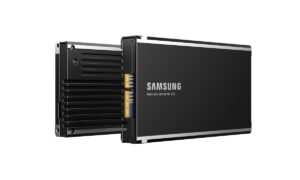Samsung Electronics held a second-quarter financial conference call today and released its second-quarter financial report. Samsung said consolidated sales for the quarter were 77.2 trillion won and operating profit was 14.1 trillion won. Despite extremely difficult business conditions such as inflation and supply chain issues, Samsung Electronics recorded its highest Q2 sales and historical second-quarter sales.
JOIN TIP3X ON TELEGRAM
In addition, Samsung’s DS (Device Solutions) segment posted a record quarterly revenue for the second consecutive quarter, while the DX (Device Experience) segment posted a significant year-on-year increase in revenue; the system semiconductor business achieved a record quarterly profit; SDC (Samsung Display) mobile display revenue and operating profit hit record highs in the second quarter.
Revenue from the MX (mobile experience) business was said to have declined sequentially due to higher material and logistics costs, but increased year-over-year, driven by sales of high-end models. Revenue from the network business increased from the previous quarter and added DISH Network as a customer.
Samsung also announced that in the second half of the year, the DS division will focus on expanding advanced nodes and new applications, and the DX division will strengthen its leadership amid macroeconomic uncertainty.
According to the financial report, Samsung Electronics’ sales in the quarter were 77.236 trillion won, an increase of 21.25% year-on-year, and an estimated 76.65 trillion won; operating profit was 14.971 trillion won, an increase of 12.18% over the same period last year, and an estimated 14.44 trillion won. The operating profit this time was in line with the market forecast of 14.710 trillion won by United Information MAX.
This quarter, Samsung Electronics’ net profit was 10.988 trillion won, a year-on-year increase of 15.2%, and an estimated 11.2 trillion won. Samsung Electronics second-quarter chip profit was 9.98 trillion won, compared with an estimated 11.08 trillion won. Display business profit was 1.06 trillion won, compared with an estimated 907.76 billion won.

Semiconductor quarterly revenue hits record high
The DS division’s second-quarter consolidated revenue was KRW 28.5 trillion and operating profit was KRW 9.98 trillion. The memory business improved year-over-year and quarter-over-quarter, driven by a disciplined sales strategy to meet market demand and the benefit of a strong U.S. dollar. While server demand remained solid, DRAM and NAND shipments fell below single-digit growth guidance as the impact of macro concerns widened and demand for consumer products such as mobile weakened.
In DRAM, Samsung achieved product sales that were unmatched by any quarter in the industry for servers, but missed forecast guidance for year-over-year growth due to weak demand for consumer products such as PCs and mobile.
In terms of NAND, Samsung continued to expand the proportion of 512Gb and above high-density products in server SSDs. But overall bit growth was lower than expected as mobile demand fell well short of expectations.
Looking forward to the second half of the year, with major data center companies as the core, investment in core infrastructure and new growth areas such as artificial intelligence and 5G is expected to continue to expand, and the fundamental demand for servers will remain stable. Customers may temporarily adjust inventory levels due to some IC component supply issues and concerns over a general economic downturn and geopolitical issues.
Demand for consumer products such as personal computers and mobile devices is likely to remain weak. For PCs, the slump in demand could extend to the enterprise space. Nonetheless, the year-end promotional season is also likely to stimulate consumer demand.
In the second half, Samsung Semiconductor aims to achieve further revenue and earnings growth by expanding its 5G SoC lineup and expanding its customer base to maximize the supply of its 200-megapixel image sensors.
Thanks to yielding improvement, stable demand for advanced processes centered on high-performance computing, and stable demand for mature processes in various applications, the foundry business achieved the highest revenue in the second quarter ever, and also achieved the second quarter’s highest profit. In addition, Samsung also said that it has enhanced its technological competitiveness through the mass production of the world’s first 3nm GAA process completed in June.
In the second half of the year, despite geopolitical issues and inflation uncertainty, the company still believes that high-performance computing and 5G-related demand will remain stable. Through close collaboration with customers, Samsung aims to outperform market growth through improved yields on advanced processes and appropriate pricing strategies.
In addition, Samsung plans to promote the completion of the second-generation GAA process development and expand the customer base for large orders. In October, offline forums will be held in the US, Europe, Japan and South Korea to further strengthen the customer network.
SDC earnings to improve with new product launches in 2H
SDC reported second-quarter consolidated revenue of KRW 7.71 trillion and operating profit of KRW 1.06 trillion. Looking ahead to the second half of this year, in the smartphone market, Samsung expects earnings to increase compared to the first half of the year as major customers are about to release new products.
However, earnings could be more volatile than last year due to some unpredictable external factors. Samsung expects sales of its OLED panels to continue to expand, as the high-end product line has a higher proportion and is relatively immune to economic fluctuations.
Mobile business 2H focuses on flagship sales and multi-device experience
The combined revenue of the MX and Networks businesses in the second quarter was KRW 29.34 trillion and operating profit was KRW 2.62 trillion. Overall market demand declined from the previous quarter due to geopolitical concerns and inflation concerns, as well as persistently weak seasonality. Profitability decreased from the previous quarter due to higher component and logistics costs and the negative impact of foreign exchange fluctuations.
However, supply disruptions in the first quarter were mostly resolved in the second quarter, with Samsung securing year-over-year revenue growth with solid sales of flagship models such as the Galaxy S22 series and Galaxy Tab S8 series.
Samsung expects smartphone market demand to maintain year-over-year or single-digit growth in the second half of the year amid persistent geopolitical issues and economic uncertainty. However, the company is aiming to expand flagship sales by successfully launching new foldable models.
Although the global smartwatch market may be affected by economic uncertainty in the short term, with the release of new smartwatches, Samsung believes that it will continue its high growth momentum and expand the Galaxy series of ecological devices.













